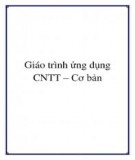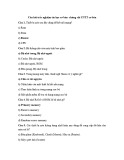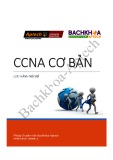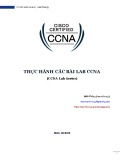
CCNA – Show Command Questions
Here you will find answers to Basic Command Questions
Question 1
Refer to the exhibit. What can be determined from the output?
A. 192.168.1.2 is local to the router.
B. 192.168.3.1 is local to the router.
C. 192.168.1.2 will age out in less than 1 minute.
D. 192.168.3.1 has aged out and is marked for deletion.
Answer: B
Explanation
The “Age” field in the “show ip arp” command is the age in minutes of the cache entry.
A hyphen (-) means the address is local so in this case 192.168.1.1 & 192.168.3.1 are
local to this router -> B is correct.
Note: The “Age 0″ means that the address was cached less than 1 minute ago.
Question 2
Refer to the exhibit. What could be possible causes for the “Serial0/0 is down” interface
status? (Choose two)
A. A Layer 1 problem exists.
B. The bandwidth is set too low.
C. A protocol mismatch exists.
D. An incorrect cable is being used.
E. There is an incorrect IP address on the Serial 0/0 interface.
Answer: A D
Explanation

The first part of the “Serial0/0 is down, line protocol is down” indicates a layer 1 problem
while the second part indicates a layer 2 problem -> A is correct.
Some popular layer 1 problems are listed below:
+ device power off
+ device power unplugged
+ loose network cable connection
+ incorrect cable type
+ faulty network cable
Answer B “The bandwidth is set too low” will not make a layer 1 problem.
Answer C is a layer 2 problem.
Answer E is a layer 3 problem.
Question 3
Which line from the output of the show ip interface command indicates a layer 1
problem?
A. Serial0/1 is up, line protocol is down
B. Serial0/1 is down, line protocol is down
C. Serial0/1 is up, line protocol is up
D. Serial0/1 is administratively down, line protocol is down
Answer: B
Explanation
Same as question 2.
Question 4
Refer to the exhibit. What is the meaning of the output MTU 1500 bytes?
A. The maximum number of bytes that can traverse this interface per second is 1500.
B. The minimum segment size that can traverse this interface is 1500 bytes.
C. The maximum segment size that can traverse this interface is 1500 bytes.
D. The minimum packet size that can traverse this interface is 1500 bytes.
E. The maximum packet size that can traverse this interface is 1500 bytes.
F. The maximum frame size that can traverse this interface is 1500 bytes.
Answer: E
Explanation

The Maximum Transmission Unit (MTU) defines the maximum Layer 3 packet (in bytes)
that the layer can pass onwards.
Question 5
The network administrator normally establishes a Telnet session with the switch from
host A. The administrator’s attempt to establish a connect via Telnet to the switch from
host B fails, but pings from host B to other two hosts are successful. What is the issue for
this problem?
A. Host B and the switch need to be in the same subnet.
B. The switch needs an appropriate default gateway assigned.
C. The switch interface connected to the router is down.
D. Host B need to be assigned an IP address in vlan 1.
Answer: B
Explanation
Host A (172.19.1.1) and the management IP address of the Switch (172.19.1.250) are in
the same subnet so telnet from host A to the switch can be successful even if a default
gateway is not set on host A.
Although the switch has an IP address in Interface Vlan1 but it does not have a default
gateway command pointing to the ip address on interface 172.19.1.254 -> B is correct.
Question 6
Which command displays CPU utilization?
A. show protocols
B. show process
C. show system
D. show version

Answer: B
Explanation
The “show process” (in fact, the full command is “show processes”) command gives us
lots of information about each process but in fact it is not easy to read. Below shows the
output of this command (some next pages are omitted)
A more friendly way to check the CPU utilization is the command “show processes cpu
history”, in which the total CPU usage on the router over a period of time: one minute,
one hour, and 72 hours are clearly shown:

+ The Y-axis of the graph is the CPU utilization.
+ The X-axis of the graph is the increment within the period displayed in the graph
For example, from the last graph (last 72 hours) we learn that the highest CPU utilization
within 72 hours is 37% about six hours ago.
Question 7
Refer to the exhibit. You are connected to the router as user Mike. Which command
allows you to see output from the OSPF debug command?


![Giáo trình Tin học (Trình độ CĐ/TC) Trường Cao đẳng Nghề An Giang [Mới nhất]](https://cdn.tailieu.vn/images/document/thumbnail/2022/20220815/viastonmartin/135x160/5641660578046.jpg)








![Bài tập Tin học ứng dụng [nâng cao/cơ bản]](https://cdn.tailieu.vn/images/document/thumbnail/2025/20250824/shenkilltv@gmail.com/135x160/60111756087501.jpg)




